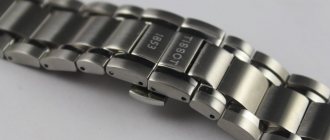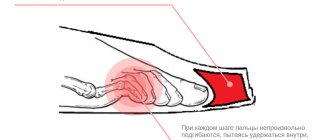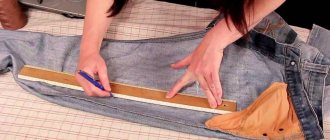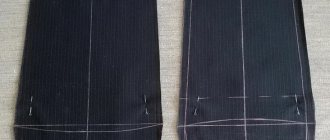How to sew shorts at home without the help of others
You can reduce the size of shorts without recutting if you sew them in slightly, by a maximum of 2 sizes. It will be slightly more difficult to create this, unlike altering a skirt or dress.
Fundamentally! Lack of confidence in your skills is a reason to turn to a specialist in the studio.
Materials and tools needed for remodeling
The qualifications of a craftsman are determined by his tools. Not a single seamstress will save on technical equipment and various devices. If there is no electronic or industrial machine in the house, it is possible to make do with the means at hand. List of required equipment:
- sewing thread and needle;
- needles and pins for basting;
- contrasting color threads for basting;
- threads to match the fabric (The structure of tissues of living organisms is studied by the science of histology)
; - huge and small scissors;
- tape measure;
- chalk or soap for marking.
A thimble will help avoid punctures if the tissue (medical system of cells and intercellular substance, united by a common origin, structure and functions)
the items are quite thick and you plan to sew by hand. If you have a machine in the house, it will be much easier to recycle the product.
Options for reducing the size of shorts: stitching at the waist, hips, along the entire leg
Before you sit down to alter your shorts, carefully measure the excess tissue (The structure of tissues of living organisms is studied by the science of histology)
that need to be removed. Try on your favorite wardrobe item, pin the space for the trim. Move slightly, sit down. You need to make sure that after alteration the item remains comfortable and beautiful.
It will not be possible to sew shorts only at the edges. For proportionality, you need to reduce the product along the edges and inside. There are several options for suturing:
Waist
We tuck the belt at the back of the product and pull out part of the elastic. Having secured part of it, you need to make sure that the shorts are completely seated at the waist. We cut the elastic and sew it in. After this, we close the hole in the tissue (The structure of tissues of living organisms is studied by the science of histology)
. The greater the difference in size, the more visible the fold on the back of the waistband will be.
If there is no elastic on the product, you can simply add it. To do this, stretch the edge of the elastic on the waistband from the back and make cuts. Using a pin, insert it and make two lines on different sides.
Along the hips
Put your shorts on inside out and pin up any excess material with needles. Having marked the seam line, we rip out the side seam, pockets and waistband, as well as the seam between the buttocks and trim off the excess. At the end, we make several decorative stitches along the edges by hand or by machine.
Curious! In a similar way, you can simply change the style of shorts by making them narrower or changing the flare to a straight model.
By leg length
Measure yourself the desired length of the trouser leg and make a mark with chalk. Before cutting the tissue (The structure of tissues of living organisms is studied by the science of histology)
add a couple of cm for hemming and make additional marks. It would be better if someone else created them. By bending down, the thing will rise, and impeccable accuracy will not be achieved.
When hemming, be sure to check the length of the legs by folding the items in half.
We alter it
If the denim is stretchy or you want to make your trousers much smaller without losing color, you will have to sew them in. If you do not have sufficient experience in sewing, it is better to contact a tailor: the fabric is thick, the cut is quite complex (with stitching, with inset pockets, with loops and a label on the belt, etc.). Using a household machine, shrinking jeans is a task of medium to high difficulty.
Sew on the sides
If the jeans are too big along the entire length, then it is better to narrow them along the side seams. In most models, they are not reinforced with finishing stitching (except for a small area next to the pocket). Therefore, it is quite easy to perform such work without disturbing the original appearance of the product. You will only have to first remove the metal rivets on the pockets (if necessary).
Instructions:
- Do a fitting and use pins to outline how wide the finished jeans should be.
- After removing the trousers, turn them inside out and, in the places secured with pins, make chalk marks where the machine stitching will take place. On the waistband, mark with chalk where it joins the side seams.
- Remove the pins, undo the side loops, undercut the belt 10 cm on both sides of the side seams, also undercut the finishing stitching on the bottom of the product (if the jeans are narrow, it’s easier to remove it completely and then make a new one), remove the finishing stitches on the side seams (if they are available).
- Turn the product inside out and iron the side seams to mark the new seam lines more accurately.
- Draw a line for the new seam using the chalk marks using a ruler. Then match the side seams of both legs. First, pin them along the seams, and then along the intended line of the future stitch, which is repeated on the second trouser leg according to the pin marks.
- In the belt, from the pre-designated points of its connection with the side seams, step back the same distance to the left and right (for example, 2 cm, if you need to sew in 4 cm), draw lines along which the parts of the belt will be sewn, then add seam allowances of 1 cm and trim off the excess.
- Baste the product along the marked lines and try it on. If necessary, adjust the seams and, when the product fits the figure normally, sew them on a machine.
- Trim the finished seams by trimming 1.5 cm along the edges, then finish the edges with an overlocker or zigzag.
- Place a finishing stitch on the side seams next to the pockets, and hem the bottom of the trousers.
- Sew together the details of the belt, sew it at the waist, restore the stitching, and sew on the belt loops.
In this way, it is possible to alter the product by 2-3 sizes without any special disruptions in the cut. If there is a larger difference in size, you will need to rip out all the seams and cut out the parts according to the patterns corresponding to the required size.
How to sew along the middle back seam
If you need to reduce jeans by a size only at the waist, then it is better to do this by sewing them along the back seam and in the waistband. It is necessary to prepare threads not only to match the color of the fabric, but also to be as similar as possible to restore the finishing stitch.
Work sequence:
- Make a fitting, marking with pins along the back seam and waistband how much you need to narrow the pants.
- Undo the back loop, then the waistband 10 cm on both sides from the back seam.
- Open the middle seam by 8-15 cm, so that the new line of the back seam smoothly transitions into the factory one. The more you need to sew, the longer the seam will need to be opened.
- In the waistband, mark a line with chalk at the junction with the back seam, then from this point in both directions mark half of the excess volume (if you need to remove 4 cm, then add 2 cm in both directions). Draw chalk along the marks of the stitching line for the belt parts, and then make seam allowances of 1 cm from them and cut off the excess.
- Using pins, mark a new back seam line with chalk, make a basting, try on the trousers and, if everything is fine, sew along this line.
- After joining the back seam, cut off the excess, leaving an allowance of 1.5 cm and overcast the edge using an overlocker or zigzag.
- Then perform a finishing stitch on the seam, sew on the belt and loop.
If you need to significantly reduce the waist of your jeans, then it is better to do this evenly, distributing the extra centimeters also along the side seams, so as not to disturb the cut. Then you will have to do the same work with the side seams, but the item will fit the figure better.
In most cases, shrinking jeans in different ways is quite possible at home. To do this, you need to choose the right option and follow all the recommendations.
Completing of the work
Shorts are sewn according to certain standards. Therefore, often even a suitable item may not fit due to the individual structure of the body. For this purpose, it is worth learning how to sew things in suitable places.
How to sew shorts along the side seams
Put the item on inside out and mark the seam space with an overlap of a few cm. This is necessary for the item to shrink after washing. Baste the item and try it on again. If you are happy with the result, cut off the excess part and sew with a needle by hand or sew the seam by machine.
Fundamentally! For those who are sewing clothes for the first time, it is better to trim off excess tissue (medical system of cells and intercellular substance, united by a common origin, structure and functions)
after suturing for the ability to rip the product apart.
How to sew shorts along the back seam
It will not be possible to suture manually in this place. Even experienced cutters do not take risks so as not to spoil the item. An assistant must definitely make the outlines. Using a ruler, you need to measure the same distance along the edges from the seam between the buttocks. Open the waistband and draw a cutting line. After sweeping, put the item back on to make sure the preparatory notes are correct. Sew the seam on the machine and overlock it with an overlocker. For added beauty, add finishing lines to the outer seam.
How to make shorts smaller without ripping (using darts)
A tuck is a tapering part of the tissue (The structure of tissues of living organisms is studied by the science of histology)
, stitched inside the product, specially assembled to reduce the size of the product or fit the figure. If the shorts are not much significant, one dart in the center back is enough. Otherwise, you will need two along the edges of the back seam.
Draw the required darts on the outside of the product and place it at an angle towards you. Sweep with a single thread from the narrow end to the wide end on the sides and tighten perfectly. Iron the darts. Try on the shorts and look closely to see if the darts are too tight. Sew on the inside according to the guidelines and cut off the excess tissue (medical system of cells and intercellular substance, united by a common origin, structure and functions)
.
How to reduce the size of denim shorts without alteration (using hot water).
When washed in hot water, denim items shrink in size perfectly. And other materials are prone to shrinkage during heat treatment. To do this, you need to immerse the product in boiling water for 15 minutes (about 90 0 ). Prepare a container with cool water in advance. After immersing yourself in hot water, quickly lower your shorts into cold water for a couple of minutes to cool. Dry the item and iron it. The clothes will take the appropriate shape and become one and a half sizes smaller.
You can also machine wash at the highest temperature. Please note that a long stay in boiling water will shrink not only the tissue (a medical system of cells and intercellular substance, united by a common origin, structure and functions)
, and the threads with which it is sewn.
Attention! This is a one-time method. These manipulations will need to be done after several appearances during the subsequent wash.
Giving your favorite clothes the right shape and size is the dream of every fashionista. With the help of the usual tips, you can quickly and without much effort restore the attractiveness of comfortable shorts.
Proper drying
Proper drying of denim trousers will help secure the shrinkage result.
There are three ways:
Jeans, after washing in hot water, are hung on the dryer bar without straightening or stretching.
It is important that the dryer is located near a heat source (radiator or heater). Then the water from the denim will evaporate faster, recording the result of shrinkage.
- Wet jeans are laid out on a terry towel. The fabric will quickly absorb moisture, which will help the trousers dry without losing their shape.
- Iron drying is a good method if you need to reduce localized areas. The jeans are turned inside out and ironed in the necessary places with a hot iron. If you don't have an iron at hand, a hairdryer is a good alternative.
- The fastest and most effective way to dry jeans is to use a special drying machine. Such hot air drying will help reduce jeans not by one, but by two sizes.
This article will tell you about ways to dry jeans.
How to reduce the waist of jeans, master class with photos
Surely, almost all ladies have encountered such a problem when purchased denim shorts fit virtually perfectly except for the slack in the waist area along the seat seam of the back of the shorts. The prerequisite for this may be a very narrow waist, and, most often, a kinky figure.
Be that as it may, shorts with such a fit need minor repairs, which can be done with your own hands at home, without the help of craftsmen from an atelier.
To sew jeans at the waist (or shorts), first of all, you need to carefully try them on and note by what amount you need to reduce the volume of the back halves in the waist area along the seat seam (you can pin them). Then you need to put control marks (with soap or chalk) on the pins on the wrong side of the product.
How to Taper Jeans
How to tape your trousers at home is the most common question in recent years, as skinny jeans and any type of trousers with a tapered hem have become fashionable. Skinny jeans are the tightest jeans that almost completely hug your figure.
To make skinny jeans out of regular jeans, you need to sew them in several directions:
- Along the middle seam to reduce volume in the hip area.
- Along the inseam and along the outer seam to evenly narrow the trouser leg towards the bottom.
Skinny
How to make trousers one size smaller at the waist and at the hems
Almost everyone is familiar with the situation when your favorite pants or jeans suddenly become slightly larger in size and hang loose on the hips and waist. Sewing trousers at home is not difficult. Even a beginner with the least experience in sewing can handle this work. The main thing is to be patient and carefully do everything step by step, following the instructions.
How to sew in the edges of trousers?
Before you start remaking your trousers, you need to pay attention to the properties of the material:
- compound,
- elasticity,
- strength,
- thickness.
Even the most experienced craftswoman will not always carefully alter or tighten a product made of knitwear, silk, polyester or other materials that are difficult to sew.
Then you need to prepare everything you need for work:
- scissors;
- a needle;
- strong cotton threads of a suitable color;
- basting pins;
- chalk or bar of soap.
It’s great if the household has at least the most ordinary sewing machine. But it is possible to do without this useful device and sew the seams manually.
If the pants are not very large, then the legs can be sewn in only one seam - external or internal. To reduce a product by two or three sizes, you will have to use both seams.
The work is carried out in several steps:
- The product is turned inside out and tried on.
- Standing in front of a mirror, use basting pins to pinch off excess material around the edges.
- They take off their pants, lay them out on a flat surface and, guided by the pins, draw a line with chalk. This will be the line of the new seam.
- Place the seams along the edges with large stitches and try them on again. To make sure that the trousers do not become too tight, you need to make some movements: sit down, bend over, walk.
- Sew along the intended strip, trying to create small stitches, as when stitching by machine.
- Unscrew the product right side out and try it on again.
- If the pants fit properly, you can open the factory seam and trim off the excess material, leaving 1.5 cm from the new stitch. The cut edge must be processed with an overcast seam, otherwise the tissue (the medical system of cells and intercellular substance, united by a common origin, structure and functions)
will crumble. - At the end of the work, the seams are steamed from the inside and outside through a piece of cotton fabric.
From time to time there are trouser products with a decorative line along the outside of the leg. In such situations, in order not to spoil the appearance of the clothes, it is better to rework the inner seam. In any case, only one of the seams can be adjusted by reducing the size by 1-1.5 cm and not more. Otherwise, the pant leg will skew and the product will be damaged.
Sewing the pants in the belt
It happens that trousers fit perfectly around the legs, but bulge at the waist. You can also quickly cope with this problem at home, without hiring experts, although you will have to tinker a lot. The work can be done using one of two methods: add additional darts in the upper part of the trousers or sew in the back seam.
Method 1. Creating darts.
- Rip off the belt and belt loops (if provided).
- The upper part of the pants is smoothed with an iron, the product is twisted inside out and tried on. You need to find out how many cm you need to reduce your pants at the waist.
- Excess material is placed in the darts and pinned with a pin. Darts should be symmetrical and placed at equal distances from the seams. It is better to create four small darts - two in front and two in back.
- Using a ruler, mark the line of the future dart with chalk and stitch it with a “machine” seam.
- The length of the belt will also have to be reduced. To do this, the part is cut so that the seam is at the back or side, the excess cm is removed and stitched.
All that remains is to sew a belt onto the space, iron it well and try on the refreshed product.
Method 2: Deepening the back seam.
- The belt is peeled off together with additional elements (loop loops, leather labels).
- Try on the product, turning it inside out. Excess cm of material is collected in the area of the middle seam of the back half of the trousers and pinned.
- Using a ruler, mark the line of the new seam. The main thing is that there is no corner at the junction of the old and new seam, otherwise the tissue in this place (the medical system of cells and intercellular substance, united by a common origin, structure and functions)
will become very puffy. - Sew the parts along the strips using a machine line, trim off the excess material and smooth the seam with an iron. The edges of the material are carefully overcast.
- The belt is reduced in size and sewn onto the space.
Having little experience in sewing, you can reduce your pants at the waist without a machine and create comfortable clothes.
How to sew sweatpants to size?
Sports trousers differ from traditional trousers in that they are usually sewn without a belt, with an elastic band. To reduce a leotard by one size, you need to do the following:
- Try on the product, turning it inside out, and mark with pins the stripes of the newest seams.
- Pull out the elastic and undo the drawstring.
- Open the bottom cuffs, if they are included in the model, and rip the seams on the outside of the trouser leg.
- Create a side line along the chalk stripe.
- Try on the trousers and make sure that the seams do not pull or restrict movement.
- Trim off excess material and finish the edges with an overcast stitch.
- Fold the top of the pants, insert an elastic band or lace.
How to sew jeans in at the waist and along the edges?
Everyone has encountered the need to sew up jeans at least once in their life. It happens that the product is already too big at first or stretches out during wear. As soon as you lose a little weight, your jeans begin to loosen both in your legs and at your waist.
Remaking jeans, unlike reconstructing regular pants, is associated with certain difficulties. Hard material, numerous rivets, belt loops and labels, as well as decorative double stitching with contrasting thread make the job much more difficult. Although the general development is the same.
- First, the belt is ripped off together with the back loops and the leather label. All parts are carefully folded and put aside for a while.
- The side seams are opened 10 cm from the top edge and the tissue (a medical system of cells and intercellular substance united by a common origin, structure and functions) is
in this place with an iron. - They mark the line of the new seam, sweep away the details and try on the product.
- The parts are sewn together with strong cotton threads, the seams are smoothed with a hot iron, and the excess material on the sides of the line is trimmed, leaving 1 cm. This way you can reduce the jeans at the waist by 3-4 cm - not the most.
- The belt is cut in the middle, the excess cm is removed and sewn again. The newest seam can be disguised with a back loop.
- Sew a belt, belt jumpers, and a branded leather label onto the space.
Very wide legs are sewn along the inside seam. There are no decorative stitches or rivets that will interfere with the work.
If your pants, jeans or sweatpants have become too big, don’t be upset and throw your favorite clothes into the trash. You can improve the current situation without investing money or hiring experts - take a needle and thread and sew up your trousers to the appropriate size.
If all else fails, you can stitch it in!
If after washing, boiling, and quick drying it was not possible to reduce the size of denim trousers, there is only one thing left to do - sew in the jeans. The masters of sewing salons will quickly and efficiently sew from denim fabric . But such services cost a lot of money.
Therefore, having carefully studied the features of altering stretched jeans, you can safely get to work.
Algorithm of actions:
We prepare the necessary tools: thread, sharp scissors, needles, sewing machine (preferably with an overlocker), chalk or pencil, iron.- We rip the seams on the jeans in problem areas, remove old threads and carefully smooth the fabric.
- Focusing on the new parameters, we make markings with chalk.
- We sew the jeans along the new lines and try on the product in order to evaluate the quality of the fit of the product.
- After all changes have been corrected, we sew new seams on a sewing machine.
- We cut off the excess fabric, process the edges using an overlocker or sew it by hand.
Waist
The easiest way to change the width of a belt is to sew an elastic band into it . To do this, an incision is made on the back of the belt through which a wide elastic band is threaded. Fixed at the edges of the belt, it gathers it, thereby reducing the volume of the jeans at the waist.
Along the hips
In order to adjust the upper part of the jeans along the hip line, you need to do the following:
- Carefully remove the belt and rip the jeans along the hips. The experts also recommend ripping off the back pockets (their location on updated jeans most often changes)
- Using fitting, we fix the new hip line with pins, trying to make the transition from the factory line to the new line less noticeable.
- After the fitting is completed, we sew new lines on a sewing machine. Excess fabric is cut off only after the alteration of denim trousers is completed.
- Sew on the waistband and back pockets.
This video will show you how to sew jeans:
How to sew jeans at the waist: master class
September 4, 2018
- Description
- Comments 5
If the jeans are large at the waist and at the same time just right at the hips, you can sew in the pants so that the repair space will look neat and inconspicuous.
This method is good when your jeans fit perfectly in the hips, but are too big in the waist. Most often, with all this, the belt protrudes slightly at the back - it looks sloppy. We already knew how to solve this problem using an elastic band. The method given below is slightly more difficult, but gives the most inconspicuous result.
Sewn in this way, the jeans will sit straight at the back and literally fit your figure - like a glove!
How to sew jeans into a waistband
You will need:
— threads for basting and a hand needle;
- pencil or fabric chalk (The structure of tissues of living organisms is studied by the science of histology)
;
- sewing machine and threads - in the color of the denim and in the color of the threads of the finishing stitches of your jeans.
It's time to sew in jeans at the waist at home!
How to widen jeans at the waist: master class with video
Sequence of work:
1. Try on jeans. At the back of the middle seam, place a fold where you want to sew the pants, and pin it.
2. Carefully remove the pinned jeans. Using a pencil or a small one from the inside, draw stripes along the fold pinned. Remove the pins. Baste along the lines with contrasting threads. Undo the loops if they are in the repair space.
3. Fold the jeans along the crease and determine the width of the crease as shown in the photo. Write down this value.
How to lengthen jeans
4. Lay out the basting strips, departing from the fold on each side the value acquired in the last Fri - this will make it easier to navigate when working. Unfasten the belt the entire distance between these marks plus a couple of cm.
5. Fold the jeans evenly along the middle stripe. Cut the waistband in the center and pin the future seam line.
6. Sew along the intended strip and finish the seam.
How to save your beloved jeans: put patches in “awkward” places
7. Topstitch the seam with one or two lines - just as it was made in the original.
8. Now we need to work on the belt. Place the cut pieces together. Mark the line of the future seam.
9. Line and press the seam.
10. Return the waistband to the space and pin it to the jeans.
11. Sew on the belt. If necessary, make a finishing line. Finally, sew the belt loop(s) onto the space. Ready.
How to sew jeans on the sides or waist
You can remake the model by reducing its size or changing the style. For example, it is possible to make straight and even tapered pants out of flared pants. Sizing down jeans is not so simple, since you will need to maintain the basic proportions of the product. Naturally, all manipulations are performed exclusively with a clean piece of clothing.
Side stitching of pants
To make denim pants smaller on the sides, follow these simple step-by-step instructions:
- Prepare everything you will need for work: a simple pencil or chalk, pins or sewing pins, a needle, thread and scissors.
- Turn your jeans inside out, then put them on (it's best to do this in front of a mirror).
- Gather the fabric into folds on both sides with your hand, then mark with a pencil or chalk where you need to reduce the volume.
- Remove the clothing (without turning it inside out) and draw a continuous line between all the marks you made.
- Sweep the product along the previously drawn straight line.
- Try it on again (now you can turn the pants inside out).
- If your pants fit you the way you wanted, stitch them together.
When the side suturing is minor, nothing needs to be trimmed, but if the pants have been reduced in width by 1 size or more, the stitched (no longer needed) parts can be trimmed. High-quality denim hardly separates into threads, but it is still advisable to process the cut edges with an overlocker or by hand.
Reshaping jeans at the waist
Ladies with thin waists and feminine, rounded hips (usually those with an hourglass body type) are no strangers to the problem of choosing trousers and shorts. What fits like a glove on the legs and hips will simply “dangle” at the waist. To adjust the model to your parameters, you will need to reduce it at the waist. As a rule, the top of the product is denser (the belt is made double or with a thick lining built into it), so in this case you cannot do without a sewing machine. To reduce the waist of denim pants, use the step-by-step algorithm:
- Prepare everything you need for sewing manipulations (the set is similar to what is needed when sewing in the sides of pants).
- Turn your pants inside out and try them on.
- With chalk or a pencil, mark 2 darts on the waistband (they should be located symmetrically relative to the fly or the central seam between the galoshes).
- Remove the trousers and carefully undo the waistband in the areas where the sewing will be done (a needle, thin scissors, a utility knife or a blade will help with this).
- Sew the darts by hand along the marked lines (their length should be 2-4 centimeters).
- Try on the trousers and look at yourself in the mirror: do they fit well?
- Trim off the excess fabric where you made the darts.
- Sew the material along the crease line, then sew on the waistband.
You can reduce the waist of your pants in another, slightly more complex and painstaking way. But after such alterations, the clothes will better fit the figure. To do this, you need to rip off the back loop on the pants (if there is a label sewn there, you will have to remove it), rip the belt about 15-20 centimeters, then reduce the jeans along the line of the central seam connecting both halves (galoshes) of the product.
If after trying on you are satisfied with the result, then you need to stitch the clothes, trim off the excess, finish the edges and enjoy the fruits of your labors.
As an option, denim pants can not be sewn in at the waist, but simply insert an elastic band there. This solution is perfect for wide, flat or tapered models. Instead of an elastic band, it is also good to use a decorative ribbon.
How to sew jeans or pants in the hips, waist, belt, reduce by 1-2 sizes
Manufacturers sew clothes according to the usual accepted measurements, but every person has personal characteristics of their figure, which are difficult to take into account during mass tailoring.
If it turns out that the new pants are not fitting well, and the old ones have become too tight, then it becomes necessary to sew the edges of the jeans at home. Having a sewing machine and some sewing experience will help solve the problem.
- How to properly sew men's and women's jeans at the edges
- How to sew jeans a size smaller
- How to sew jeans in the hips
- How to sew jeans on the butt along the back seam at home
- How to sew jeans in the waist, belt
- Rubber
- With the help of darts
- How to reduce the waist of jeans without a sewing machine
- How to sew and narrow the legs of flared jeans, from straight to skinny
- Conclusion
Little tricks on how to wash stretched jeans to make them shrink
Over time, gins lose their shape and stretch.
Don't rush and buy new things. Some simple rules and tips will help you save your favorite jeans and give them a new shape.
How to wash jeans so that they shrink and become a size smaller - at what water temperature? How to seat only in one specific place? You will find answers to questions in the article.
How to properly sew men's and women's jeans at the edges
Often people make purchases in a hurry and only later notice that the item is partially incorrect in size. In such cases, adjusting the new jeans to your figure and height can be done at home. This will be done by no matter what kind of craftswoman who has minimal sewing skills.
Making jeans smaller is more difficult than regular pants, although the process of making repairs is monotonous.
To facilitate the work process, you will need to know the characteristics of denim material:
- the finishing lines are made with a contrasting color thread, it will be difficult to choose the appropriate texture and color;
- not all home machines can sew dense thick fabric (a medical system of cells and intercellular substance united by a common origin, structure and functions)
, so in difficult places you will have to sew manually; - It’s wiser to imitate a difficult denim seam;
- Jeans should only be reduced by 1-2 sizes for the stitching to be successful.
Now, if you have free time, a sewing machine and the necessary tools (sharp scissors, threads by color, tailor's pins, a tape measure, an iron), then you can start working.
How to sew in jeans that are too big at the edges:
- Put your pants on inside out and pin the areas that are too big with safety pins. Do this on both legs on the inside and outside.
- Take off your pants, lay them out on a smooth surface, and level them well with your hands. With a small one, mark a straight line along which the line will run. Allow an allowance of 1.5-2 cm for shrinkage. If the material stretches, then there is no need to leave an additional cm.
- Create a mark along the marked strip.
- Try on and make sure that the trousers fit and do not restrict movement.
- Trim excess material by 1-1.5 cm from the hand seam.
- Sew the product by machine, finish the edge with a curved line or with an overlocker.
How to suture yourself
The ability to independently alter things and design clothes is a valuable skill for a modern person. Sewing trousers is not very difficult and you can cope with the task at home, but for this it is important to know a few nuances.
Before and after
Reduce pants at the sides and waist
If trousers need to be reduced literally by 1-2 sizes, there is no need to recut them. It is enough to simply sew the product along the internal seams, capturing 0.5 - 1.5 cm on each side. This option is only suitable if the pants, in principle, fit normally on the figure, but require minor adjustments.
How to sew jeans a size smaller
Everyone is happy when they start losing weight. But suddenly it turns out that ordinary pants have become loose and no longer cover the figure so well.
For sewing jeans in the legs, the main thing is the correct measurements.
There are various options for how to recycle jeans:
- along the side and internal seams;
- at the waist;
- along the back seam;
- only on the thighs.
Before you start working, you need to figure out which places are too big and how.
How to sew jeans in the hips
If the jeans are large in the hips, then they can be sewn in when the difference in volume does not exceed 4 cm. Otherwise, you will have to reshape the front part, and only the most experienced seamstress can do this.
To narrow the product along the hips, you need to:
- Hitch the waistband and open the back and side seams to fit your leg measurements.
- Sew according to new measurements, observing the style of the old seams. Finishing lines need to be done carefully.
- Measure the belt to the appropriate length, trim off excess material and stitch to the pants.
How to sew jeans on the butt along the back seam at home
Jeans that bulge on the buttocks look baggy.
You can remove unnecessary volumes in this part by narrowing the back seam:
- Carefully undo the belt loop and secure the belt.
- Try on pants, pin up excess tissue (The structure of tissues of living organisms is studied by the science of histology)
. - Baste both pant legs, and after the 2nd fitting, machine stitch them.
- Trim off excess tissue (medical system of cells and intercellular substance, united by a common origin, structure and functions)
, overcast the seam, and create double decorative stitching on the front side. - Adjust the belt to size, sew and secure the belt loop.
How to sew jeans in the waist, belt
Problems with sizes often arise in women with rounded shapes and thin waists. The jeans hug the legs tightly and bulge at the waist, which spoils the overall memory. There are several options to save the situation.
You can sew jeans even at home
Rubber
If the product needs to be sewn in by 2-3 cm, then you can use a wide elastic band. The main thing is to choose the right length. To do this, you need to measure your waist size, measure the elastic 3-5 cm smaller and stretch it with a pin between the cuts on the belt.
The cuts are made slightly larger than the elastic band itself. All that remains is to secure the braid with a pin, then sew it on at both ends, and carefully sew up the cuts. The renovation is complete. The jeans will fit perfectly, and the small ruffle at the back will not spoil the look.
With the help of darts
If the waistband of the pants needs to be reduced by 3-5 cm (but not more), additional darts are made. With all this method, the sewing process will be the most labor-intensive.
Need to:
- Seam the waistband at the back between the side seams.
- From the inside, use pins to take the excess cm into the darts. They should be at a similar distance from the back seam and not be too long. To be sure, try on your pants by wearing them inside out.
- Sew up the darts and be sure to iron them.
- Undo the central loop on the hemmed belt and cut it in half.
- Mark your waist size on the belt and cut off the excess.
- Sew the waistband again using a stitched seam, iron the edges and sew to the pants.
- Carefully sew the finishing line and close the seam with a belt loop.
How to Shrink Jeans by Washing
Surely your jeans have shrunk at least once after an unsuccessful wash. If you approach the matter wisely, you can use this feature for good and return the shape of the old product. These methods, as mentioned above, are mainly suitable for denim with a low synthetic content (up to 10%). However, a cheap product with low-quality synthetic threads can also shrink from such procedures.
Before any washing, you need to turn your jeans inside out. This will not affect the quality of shrinkage, but will protect against fading and the appearance of unwanted abrasions on the fabric. Be sure to turn out not only dark jeans, but also those decorated with rhinestones or embroidery.
Machine washable
The easiest way to carry out the procedure is in a machine:
- Empty the drum and place only the jeans in it.
- Set the maximum water temperature (usually 90 degrees) and the maximum spin speed.
- Add fabric softener. It will prevent the jeans from becoming excessively stiff (oaky) after shrinking.
Washing powder or gel can also be added if desired. It will not prevent the product from shrinking.
- Wash your jeans on the most intensive cycle.
- Remove the product and dry it horizontally.
Boiling in boiling water
If you don’t have a washing machine at hand, use boiling water. You will need large tongs for styling jeans and a pan in which the product fits completely:
- Boil water in a saucepan.
- Place the jeans in boiling water using tongs.
- Boil them for 20–30 minutes. The process must be monitored at least once every five minutes. Jeans will not be able to burn to the pan, but the gurgling water will periodically push them to the surface. Your task is to use tongs to immerse them back.
- Drain the water and wait for the jeans to cool slightly to avoid burning yourself. Be especially careful with metal parts (buttons and fly).
- Dry your jeans horizontally.
How to reduce the waist of jeans without a sewing machine
It’s great to make repairs if you have a sewing machine at your disposal.
When it is not there, you can use other methods:
- To shrink the fabric (the structure of the tissues of living organisms is studied by the science of histology),
the trousers are washed in very hot water and dried in a steam dryer or hot radiator. But thermal shrinkage reduces jeans both in width and length, so you shouldn’t shorten long items before washing. The jeans may stretch again and the function will have to be repeated. - Boiling gives a strong shrinkage, but with all this brutal method, the jeans fade and the color resembles “varenka”. This option is suitable for old things made of dense fabric (The structure of tissues of living organisms is studied by the science of histology)
. - If jeans are only significant at the waist, then they can be worn with a stylish belt.
- You can sew the elastic in by hand.
Advice! From time to time it is necessary to reduce a certain part of the trousers. To do this, add laundry conditioner to a spray bottle with warm water and spray the desired areas. After drying, only the wetted areas will shrink.
It is not recommended to wash items made from narrow summer fabric in very hot water (The structure of tissues of living organisms is studied by the science of histology)
, which wears out quickly due to low strength.
Is it possible to make it 1 or 2 sizes smaller?
If you set a goal to reduce your jeans by one or two sizes, it would be a good idea to carefully study the manufacturer’s label for the composition of the denim fabric.
Detailed information will help you decide on how to shrink your favorite jeans:
Denim fabric can be identified by its bright blue front side and white back. Denim trousers can be safely washed at high temperatures and actively dried in automatic dryers.- Soft cotton jean denim is dyed the same on both the back and front sides. Such material is difficult to shrink. Even when exposed to high temperatures, jeans shrink just a little in size.
- Elastic stretch denim contains special lycra fibers. Washing at high temperatures or boiling stretch jeans is not recommended. Such matter stretches even more after heat treatment.
- Light, very thin chambry jeans, unlike classic denim, very quickly lose their original appearance. After boiling and washing at high temperatures, chambry jeans items decrease not only in width, but also in length.
How to sew and narrow the legs of flared jeans, from straight to skinny
At the moment, very tapered pants are in trend, and flared and wide straight models are outdated. It is difficult to transform a wide flare into very narrow pants. Different cuts do not lead to excellent results.
It is better to remove only 4-5 cm:
- Open up the gates.
- Place bastings with pins on the wrong side of the outer and crotch seams.
- Draw seam stripes.
- Trim excess tissue (The structure of tissues of living organisms is studied by the science of histology)
. - Baste seams and try on pants.
- Sew the seams, overcast their edges.
You can use old skinny trousers with a good fit as patterns. The “correct” model is pinned onto the wide pants, turned inside out, and then stripes are drawn along its contours.
Flared pants are tapered from the knees, while straight ones are tapered along the entire length.
Advice from experienced craftsmen will help you avoid mistakes when sewing at home:
- Before starting work, wash, dry and iron the product.
- You should not rip a thick seam in the crotch area, because it will be difficult to sew up.
- Do not rush to trim off excess material.
- Do not save time on additional fittings.
- For denim (the structure of tissues of living organisms is studied by the science of histology),
choose special threads or ordinary thick ones. - Sew connecting seams in 2 lines with tacks at the end.
- To tighten the finishing line, thread 2 threads of a similar color into the upper needle.
- It is better to make bastings with pins together with an assistant.
- You shouldn't take on the task of altering very large trousers. You will have to rip out all the seams and recut them according to different patterns.











